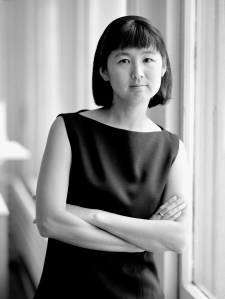Maya Lin, Silver Niagara, 2013.
Maya Lin vaulted to fame when she was just 21 as the winner of the competition to design the Vietnam Veterans Memorial. Her powerful monument led the architecture student to a robust career creating artworks, buildings, sculptures and memorials, with a growing focus on environmental issues. Lin’s latest show consists of two complementary exhibitions, in New York and London, that explore natural forms and topography. She spoke to TIME about maps, memorials and her evolution as an artist.
How do both parts of your current exhibition Here and There relate to each other?
They’re both connected to looking at our world with more of an environmental concern. The There isn’t just about London. It’s about more of a global outlook; a lot of the subjects are from all over the world. Whereas the Here show focuses solely on New York: the city, the Hudson River system, and New York State. So they balance each other—one is more local, and one is more global in outlook.
Have you always been interested in maps?
I have been interested in maps for a couple decades now. It started with explorations I would make in used atlases. I would buy them and start cutting into them, making almost sculptural drawings out of them. I work in such a large scale out of doors that the maps to me become a link, to be able to have a discourse at a smaller human scale inside. But the inside works almost always relate to a larger exterior worldview.
(MORE: 5 Questions with Art Collector and Interior Designer Maria Brito)
How has your perspective on environmental issues evolved throughout your career?
As a child I was extremely concerned with environmental issues. I actually thought I was going to become a field zoologist. It’s always come out—whether I was volunteering to be on the board of the Energy Foundation or the NRDC’s board—and I think it’s always been there in the art. From the very first, the Vietnam Memorial, it was about being extremely site-specific and site-sensitive, creating something that merged with the land around it. But much more so in the last decade or two decades, my artwork has focused on making you aware of things in the natural world that we might not be aware of. What’s invisible we tend not to think about, so I’ve made sculptures that reveal the terrain below sea level. And then What Is Missing, which I call my fifth and last memorial, really tries to make you aware of what we’re losing in terms of habitat and species loss, but also focuses on what we can do in our everyday lives, as well as let’s reimagine what the future will be. It’s a very long, ongoing project for me. I don’t think I’ve ever not cared about the environment.
How do you balance the dichotomy of being both an artist and an architect?
Carefully. I think they’re very different disciplines. For me personally, the way I make a work of art is very intuitive. I’m not going to say spontaneous because the amount of science and research that goes into some of my artworks is fairly in-depth, but in the end, the form I make is—like I wake up and I start drawing or making. There’s something very pure about it. It’s like a poem for me; it’s almost a full-blown thought. Whereas architecture is a little like writing a novel. You have to make sure your sentences work together, the paragraphs all work together, there’s an underlying theme. Both are creative, but to me they’re tapping very different sides of my brain.
You were quite young—still a college student—when you won the competition to design the Vietnam Veterans Memorial. Are there things you know now about being an architect that you wish you had known back then?
No, I think it’s the exact opposite. I think when you’re really young, you’re fearless, and when you get older, we have doubts. I think the hardest thing about being an artist is that you can do whatever you want, at which point, it is the hardest thing of all. For me, the last couple decades, it’s really about my voice beginning to be so focused at looking at the natural world and revealing aspects of the natural world that you might not be thinking of.
Do you value a sense of permanence in your works?
There is permanence, but many of the outdoor works are living earthworks, so it’s not that they stay the way I put them in. I have to let them grow into themselves. They’re permanent, but they do have a real sense of being alive and having to transform and transition through time. Maybe it’s because I grew up in southeastern Ohio, and there are these ancient earth mounds there from the Hopewell and Adena tribe. We’re looking at them 1500 years later, and they’re still evocative, though I’m sure in a very different way than when they were first put in.
Where do you go to get inspired?
On an airplane, I do so much of my sketching just looking down at landscapes, both manmade—like looking down at the crop circles—as well as when you’re going over the West, the Rocky Mountains. At the same time, just taking a walk along any waterway completely inspires me. Water is something that I can just take a look at and it’s really like infinity to me, as far as where it will take my mind.
Maya Lin’s Here and There will be on view at Pace Gallery New York through June 22, and at Pace Gallery London through May 11.
MORE: The Creative Mind: Q&A with Pop Surrealist Gary Baseman


